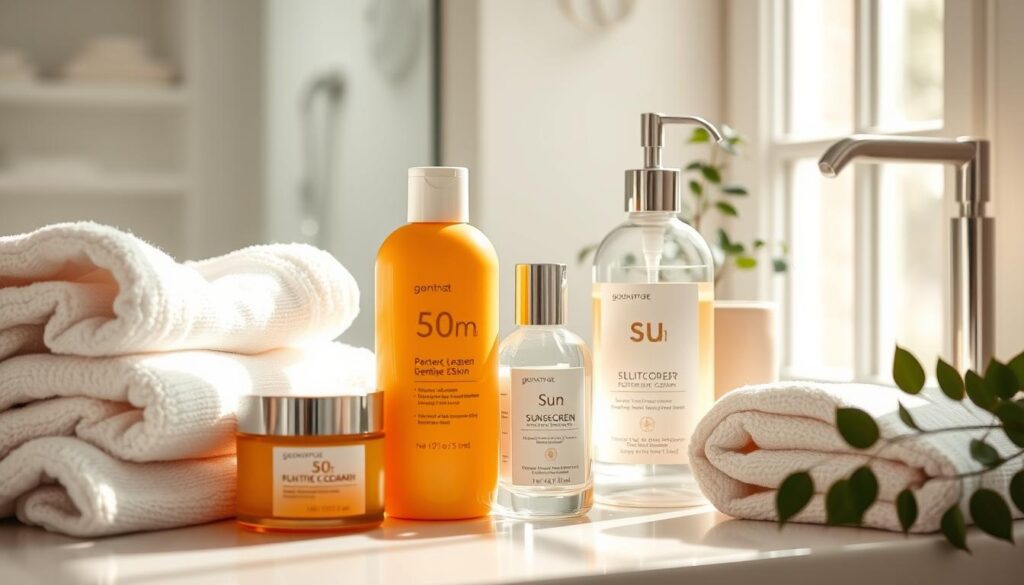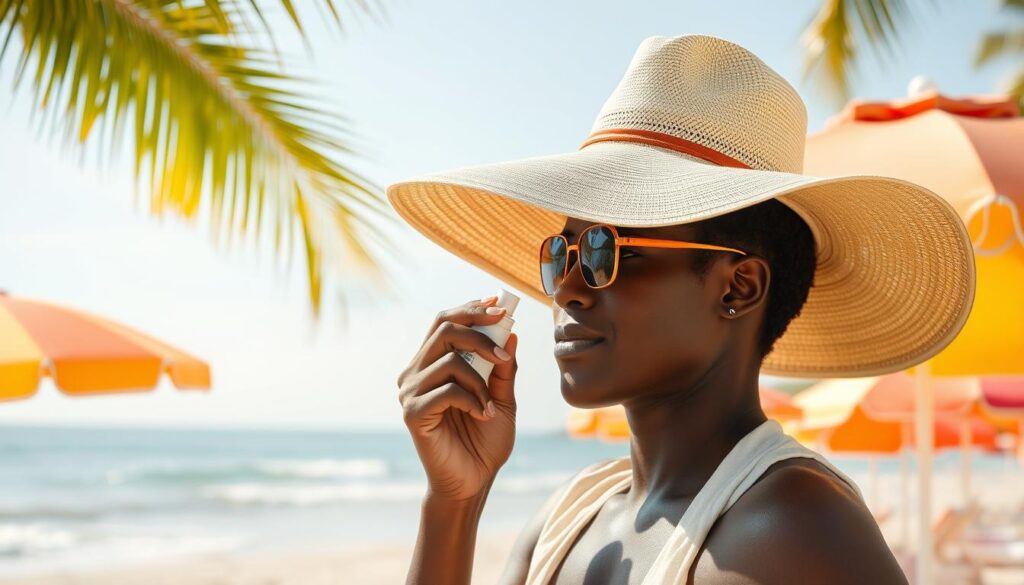Now Reading: Effective Sunscreen Use for Vitiligo Skin: Complete Protection Guide
-
01
Effective Sunscreen Use for Vitiligo Skin: Complete Protection Guide
Effective Sunscreen Use for Vitiligo Skin: Complete Protection Guide
Over 70 million people worldwide live with vitiligo. This condition causes the loss of skin pigment, making them more vulnerable to the sun’s harmful rays. It’s vital to learn how to use sunscreen effectively for vitiligo skin. This guide will cover tips and the best sunscreen for vitiligo, so you can enjoy the sun safely.

It’s important to understand how to use sunscreen for vitiligo skin to prevent further damage. By following the right tips and choosing the best sunscreen, you can reduce sun exposure risks. In this article, we’ll explore sunscreen use for vitiligo skin, giving you the knowledge to protect your skin.
Key Takeaways
- Learning how to use sunscreen effectively for vitiligo skin is vital to prevent skin damage
- Choosing the best sunscreen for vitiligo can help minimize sun exposure risks
- Vitiligo sunscreen tips can help you apply sunscreen correctly for maximum protection
- Understanding the importance of sunscreen use for vitiligo skin can help you take preventive measures
- By following the right guidelines, you can enjoy the sun safely with vitiligo
- Using the right sunscreen can help prevent further skin pigment loss
Understanding Vitiligo and Sun Sensitivity
People with vitiligo need to be careful about sun protection. This is because vitiligo makes the skin lose its natural pigment. This pigment, melanin, protects us from the sun’s harmful rays. Without it, the skin is more likely to get damaged by the sun.
It’s very important for those with vitiligo to use sunblock. When the skin loses melanin, it can’t protect itself from the sun’s UV rays. This can cause sunburn, early aging, and even skin cancer. So, it’s key to protect the skin from the sun.
What Makes Vitiligo Skin Different
Vitiligo skin is different because it lacks melanin. Melanin acts as a natural sunscreen. Without it, the skin is more at risk for sun damage. That’s why it’s so important to use sunblock and stay in the shade when outside.
Why Sun Protection is Crucial
Sun protection is important for everyone, but it’s even more so for those with vitiligo. Using sunblock, wearing protective clothing, and staying in the shade can help. These steps can prevent sun damage and stop the skin from losing more color.
The Science Behind UV Damage in Vitiligo
UV rays from the sun can harm vitiligo skin a lot. They can cause sunburn, early aging, and even skin cancer. Understanding how UV rays affect vitiligo skin is complex. But, it’s clear that extra protection is needed.
By knowing the risks and taking steps to protect themselves, people with vitiligo can safely enjoy the sun. This helps prevent sun-related skin damage.
| UV Protection Measures | Benefits |
|---|---|
| Sunblock | Prevents sunburn, reduces risk of skin cancer |
| Clothing | Provides physical barrier against UV rays |
| Seeking Shade | Reduces exposure to direct sunlight |
How to Use Sunscreen Effectively for Vitiligo Skin
For those with vitiligo, sunscreen application for vitiligo is key to avoid more skin harm. Choosing the right sunscreen and applying it right is vital. Start by picking a broad-spectrum sunscreen with a high SPF. This offers the best defense against UV rays.
Here are some tips for effective sunscreen application for vitiligo:
- Apply sunscreen liberally to all exposed skin 15-30 minutes before going outside
- Reapply sunscreen every 2 hours or immediately after swimming or sweating
- Use a lip balm with SPF to protect your lips
By following these tips and prioritizing vitiligo skin care, people with vitiligo can safely enjoy the outdoors. Always check the label and choose sunscreens made for sensitive skin.
Choosing the Right Sunscreen Type
Protecting vitiligo skin from the sun is key. With many sunscreens out there, picking the right one can be tough. It’s important to know the difference between physical and chemical sunscreens.
A physical sunscreen acts like a shield, bouncing UV rays off your skin. It’s great for sensitive skin because it’s less likely to irritate. In contrast, chemical sunscreens soak up UV rays and turn them into heat, which they then release.
Physical vs. Chemical Sunscreens
For vitiligo skin, a physical sunscreen with high SPF is best. Look for zinc oxide or titanium dioxide for broad-spectrum protection. Choose a fragrance-free, hypoallergenic option to avoid irritation.
SPF Requirements for Vitiligo
The American Academy of Dermatology suggests using sunscreen with SPF 30 daily. But for vitiligo skin, a higher SPF is often needed, more so during peak sun hours. Find a sunscreen with high SPF and broad-spectrum protection.
Neutrogena Sheer Zinc Dry-Touch Sunscreen and EltaMD UV Clear Broad-Spectrum SPF 46 are good choices. They’re fragrance-free, non-comedogenic, and offer great protection.
| Sunscreen Type | SPF | Broad-Spectrum Protection |
|---|---|---|
| Physical | 30-50 | Yes |
| Chemical | 30-50 | Yes |
Choosing the right sunscreen and following SPF guidelines can protect your vitiligo skin. Always check the label for best sunscreen for vitiligo or sunscreen for sensitive skin to get the best protection.
Essential Features of Vitiligo-Safe Sunscreens
When picking a sunscreen for vitiligo skin, look for certain key features. Fragrance-free and non-comedogenic sunscreens are best to avoid skin irritation. Also, hypoallergenic sunscreens are great for those with sensitive skin.
Here are some important features to consider for vitiligo skin sunscreens:
- High SPF for good sun protection for hypopigmented skin
- Broad-spectrum protection to block UVA and UVB rays
- Antioxidants to fight free radicals and lessen skin damage
By following these tips, you can find a sunscreen that works well for hypopigmented skin. Always check the label and choose products made for sensitive skin.
Choosing a sunscreen with these features lets you enjoy the outdoors safely. Always protect your skin from the sun to prevent damage and keep it healthy.
| Feature | Importance |
|---|---|
| Fragrance-free | Minimizes skin irritation |
| Non-comedogenic | Reduces risk of clogged pores |
| Hypoallergenic | Suitable for sensitive skin |
Daily Application Techniques
For those with vitiligo, using sunscreen right is key. It’s not just about applying it; it’s about knowing how to do it well. Start by using a broad-spectrum sunscreen with at least SPF 30 every morning.
It’s important to cover all areas with vitiligo. Here are some daily application tips:
- Apply sunscreen 15-30 minutes before going outside
- Use enough sunscreen to cover all exposed skin
- Reapply sunscreen every 2 hours or after swimming or sweating
Using sunscreen for vitiligo isn’t a one-time thing. It’s about reapplying it all day. By following these steps and choosing the right sunscreen, you can protect your skin and prevent damage.
By adding these daily steps to your routine, you can enjoy the outdoors safely. Your skin will be protected from the sun’s harmful rays.
| Time of Day | Sunscreen Application |
|---|---|
| Morning | Apply broad-spectrum sunscreen with at least SPF 30 |
| Every 2 hours | Reapply sunscreen |
| After swimming or sweating | Reapply sunscreen |
Timing Your Sunscreen Application
When it comes to vitiligo sun protection, timing is key. Applying sunscreen at the right time is vital to prevent sun damage. For those with vitiligo, it’s important to put on sunscreen before going outside, even on cloudy days.
To get the best uv protection for vitiligo skin, apply sunscreen 15-30 minutes before heading out. This lets the sunscreen soak into your skin, creating a strong shield against the sun. Also, remember to reapply sunscreen after swimming or sweating, as this can lower its effectiveness.
- Apply sunscreen daily, even on cloudy days
- Reapply sunscreen after swimming or sweating
- Use a broad-spectrum sunscreen with a high SPF
By following these tips and timing your sunscreen application correctly, you can protect your skin from the sun’s harmful rays. This helps reduce the risk of further skin damage.
Special Considerations for Different Body Areas
Applying sunscreen for vitiligo needs special care for different body parts. It helps prevent skin damage and keeps skin healthy. Sunblock is key for vitiligo skin care.
For those with vitiligo, applying sunscreen to sensitive areas is important. The face, body, and hard-to-reach spots need extra attention. A broad-spectrum sunblock with the right SPF is essential to prevent sunburn and skin damage.
Facial Application
When applying sunscreen to the face, choose a gentle, non-comedogenic product. It should not clog pores. Use a facial sunscreen and apply it 15-30 minutes before going outside.
Body Coverage
For the body, use a broad-spectrum sunblock with a high SPF. Apply sunscreen all over exposed skin. Pay extra attention to sunburn-prone areas like shoulders and back.
Difficult-to-Reach Spots
Don’t forget to apply sunscreen to hard-to-reach areas like the back of the neck and ears. Use a spray or stick sunscreen for easier application. Consider asking a friend or family member for help to ensure full coverage.
By carefully applying sunscreen to all body areas, people with vitiligo can enjoy the sun safely. Remember to reapply sunscreen often, after swimming or sweating, to keep skin protected.
| Body Area | Sunscreen Application Tips |
|---|---|
| Face | Use a gentle, non-comedogenic product and apply 15-30 minutes before going outside |
| Body | Use a broad-spectrum sunblock with a high SPF and apply liberally to all exposed skin |
| Difficult-to-Reach Spots | Use a spray or stick sunscreen and consider enlisting the help of a friend or family member |
Common Mistakes to Avoid
Using sunscreen for vitiligo skin can be tricky. There are several common mistakes to avoid. By following vitiligo sunscreen tips, you can protect your skin better.
To get the best results from your best sunscreen for vitiligo, avoid these mistakes:
- Using expired sunscreen, which may not provide adequate protection
- Not applying enough sunscreen, leaving some areas of the skin unprotected
- Not reapplying sunscreen frequently enough, specially after swimming or sweating
By avoiding these mistakes and following vitiligo sunscreen tips, you can keep your skin healthy. Always choose the best sunscreen for vitiligo that fits your skin type and needs.
Combining Sunscreen with Other Skincare Products
When it comes to vitiligo skin care, using sunscreen is key. But, it’s also important to think about how it works with other products. To get the most from your skincare, you need to layer products right. This is very true for sunscreen for sensitive skin, as it can get irritated easily.
Start by applying your skincare in a certain order. Begin with a cleanser, then toners or essences. Follow with spot treatments or serums, and end with moisturizer and sunscreen for sensitive skin. This order lets each product reach the skin well, without being blocked.

Don’t forget to wait between applying products. Let each one soak into the skin before adding the next. This helps avoid irritation and makes sure each product works well. By doing this, you can keep your skin healthy and safe, even with vitiligo skin care needs.
Product Layering Order
- Cleanser
- Toner or essence
- Spot treatments or serums
- Moisturizer
- Sunscreen
Waiting Times Between Products
Let each product soak into the skin before adding the next. This helps avoid irritation and makes sure each product works well.
Seasonal Adjustments in Sunscreen Use
For those with vitiligo, vitiligo sun protection is key all year. But, changing with the seasons can help a lot. In summer, the sun’s rays are stronger, so you need a higher SPF to protect your skin. In winter, the sun’s rays are weaker, but you must protect your skin from reflected sunlight too.
Here are some tips for adjusting sunscreen use with the seasons:
- Summer: Use a broad-spectrum sunscreen with a high SPF (at least 30) and reapply every two hours or immediately after swimming or sweating.
- Winter: Use a broad-spectrum sunscreen with a lower SPF (at least 15) and reapply every four hours or as needed.
- Spring and Autumn: Use a broad-spectrum sunscreen with a moderate SPF (at least 20) and reapply every three hours or as needed.
Other things can also affect vitiligo sun protection, like cloud cover, altitude, and reflective surfaces. By adjusting your sunscreen use and taking other precautions, you can safely enjoy the outdoors. This way, you protect your skin from the sun’s harmful rays.
Remember, uv protection for vitiligo skin is a year-round effort. Stay informed and take the right steps to keep your skin healthy. This way, you can live a better life and enjoy the outdoors safely.
Indoor vs. Outdoor Protection Needs
Protecting vitiligo skin is important both indoors and outdoors. Many people focus on outdoor protection, but indoor protection is also key. UV rays can go through windows, even on cloudy days, and harm vitiligo skin. To use sunscreen effectively for vitiligo skin, apply a broad-spectrum sunscreen with a high SPF every day, even indoors.
For indoor protection, use window films that block UV rays and wear clothes with SPF. These steps help prevent skin damage and keep your skin healthy. When outdoors, apply a higher SPF sunscreen and reapply every two hours. Knowing vitiligo and sunblock helps you make better choices for your skin.
- Apply sunscreen with at least SPF 30 before going outdoors
- Reapply sunscreen every two hours or immediately after swimming or sweating
- Seek shade, specially during peak sun hours (10am-4pm)
- Wear protective clothing, such as a hat and sunglasses, to prevent further skin damage
By following these tips andusing sunscreen effectively for vitiligo skin, you can enjoy the outdoors safely. This way, you protect your skin from harmful UV rays.
Additional Sun Protection Measures
Protecting vitiligo skin from the sun is more than just using sunscreen. There are many other steps you can take. Seeking shade, like sitting under a tree, is a great way to protect your skin. You can also use a parasol to create your own shade.
Wearing protective clothing is also key. Look for clothes with a high UPF rating to block UV rays. A wide-brimmed hat can protect your face and neck. Combining these steps with sunscreen tips helps you enjoy the outdoors safely.

- Avoiding peak sun hours (usually between 10am and 4pm)
- Wearing sunglasses with UV protection
- Using a lip balm with SPF
By following these tips, you can keep your vitiligo skin safe and healthy. Always prioritize sun protection for hypopigmented skin. If you have concerns, don’t hesitate to talk to a dermatologist.
Addressing Sunscreen Concerns and Side Effects
When using sunscreen, it’s key to know about possible concerns and side effects. People with sensitive skin might get irritation like redness, itching, or stinging. To avoid these issues, find the best sunscreen for vitiligo that’s fragrance-free and hypoallergenic.
Some common reactions to sunscreen include:
- Irritation or allergic reactions
- Breakouts or acne
- Dryness or flakiness
If you get any of these reactions, try a different sunscreen for sensitive skin. Always follow the product’s instructions. Also, apply a small amount to a small area first before using it more widely.
When to see a dermatologist? If you have severe reactions like blistering, or if your skin gets worse after using sunscreen. A dermatologist can guide you and suggest a good sunscreen for your skin type.
Choosing the right sunscreen is just the start. It’s also important to protect your skin from the sun. Do this by staying in the shade, wearing protective clothes, and applying sunscreen often. This way, you can enjoy the outdoors safely and avoid sun damage and skin irritation.
Emergency Sun Protection Without Sunscreen
For those with vitiligo, uv protection for vitiligo skin is key, even when sunscreen is not around. There are quick ways to protect your skin from the sun. One is to stay in the shade, which helps block harmful UV rays.
Wearing clothes that cover your skin, like long sleeves and pants, helps too. A wide-brimmed hat and lip balm with SPF also offer protection. Here are some quick sun protection tips:
- Seek shade, mainly during peak sun hours (10am-4pm)
- Wear protective clothing, including long-sleeved shirts, pants, and a wide-brimmed hat
- Use a lip balm with SPF to protect the lips from sun damage
By using these methods, people with vitiligo can lower their risk of sun damage. It’s important to remember, vitiligo sun protection and uv protection for vitiligo skin keep your skin healthy and prevent more harm.
Conclusion
Using sunscreen well is key for vitiligo skin to avoid UV damage. Knowing what vitiligo skin needs and how to apply sunscreen right helps. This way, people with vitiligo can feel more confident and relaxed outside.
Choose sunscreens that block both UVA and UVB rays and have the right SPF. Make sure to apply sunscreen correctly and use extra protection when needed. With the right steps, people with vitiligo can keep their skin healthy and vibrant, lowering sun-related risks.
Managing vitiligo can be tough, but staying informed and proactive about sun protection is vital. By making sunscreen use a part of your daily routine, you can protect your vitiligo skin. This lets you enjoy the outdoors more comfortably and securely. Your skin’s health is important, so it’s worth the extra care.
FAQ
What makes vitiligo skin different from normal skin?
Vitiligo skin lacks melanin, the pigment that gives skin its color. This makes it more prone to sun damage and sunburn. It doesn’t have the natural protection melanin offers.
Why is sun protection important for individuals with vitiligo?
Sun protection is key for those with vitiligo because their skin is more vulnerable to UV radiation. UV rays can make the condition worse and lead to more loss of pigmentation.
How does UV damage affect vitiligo skin?
UV radiation causes oxidative stress and inflammation in vitiligo skin. This can destroy melanocytes, the cells that produce melanin. This can cause existing white patches to grow and new ones to appear.
What are the key features to look for in a sunscreen for vitiligo skin?
Look for sunscreens that are fragrance-free, non-comedogenic, and hypoallergenic. Sunscreens with antioxidants offer extra protection.
How much sunscreen should be applied for effective coverage?
Apply 1 to 2 milligrams of sunscreen per square centimeter of skin. This means about 1 ounce (2 tablespoons) for the whole body.
How often should sunscreen be reapplied?
Reapply sunscreen every 2 hours. Do this more often if swimming, sweating, or toweling off. Reapplication keeps sun protection strong.
What are some common mistakes to avoid when using sunscreen for vitiligo skin?
Avoid expired sunscreen, not applying enough, and not reapplying often enough. Also, steer clear of sunscreens with irritating ingredients.
How should sunscreen be combined with other skincare products?
Follow the correct layering order and wait the right amount of time between products. Sunscreen should be the last step in your morning routine.
Do sunscreen needs differ between indoor and outdoor activities?
Yes, they do. Daily indoor protection is important, but higher SPF sunscreens and more frequent reapplication are needed for outdoor activities.
What additional sun protection measures should be taken for vitiligo skin?
Use sunscreen, seek shade, wear protective clothing, and use a wide-brimmed hat. These steps help protect vitiligo skin from the sun’s harmful rays.
When should a dermatologist be consulted for sunscreen-related concerns?
If you have a bad reaction to sunscreen, like irritation or an allergic reaction, see a dermatologist. They can find the cause and suggest better sunscreen options for your skin.


















